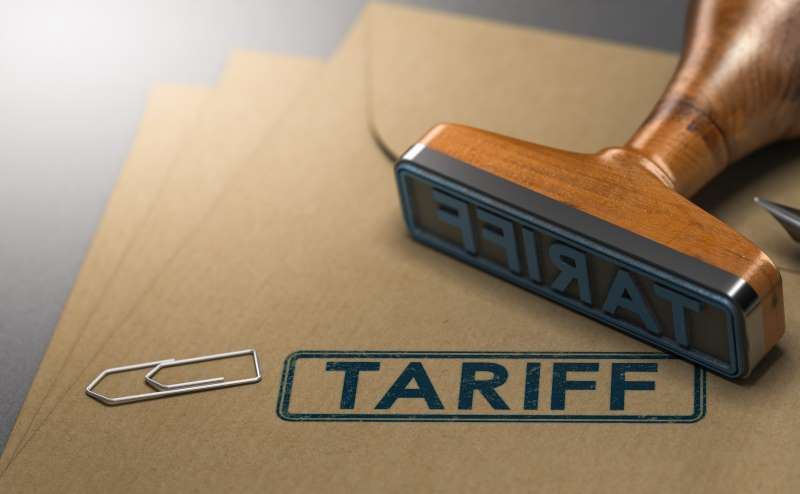Blitzing to Kick-Start Growth
Most B2B firms believe they should be growing faster. On the surface, boosting growth doesn’t seem like it should be all that difficult; many companies have multiple areas where modest improvements in performance would accelerate revenue growth. But therein lies the problem: this abundance of improvement opportunities often stymies action. Not knowing the best place to start, many management teams do nothing. This paralysis is a large part of the reason why 45% of Chief Sales Officers (CSOs) report having concerns about how they will achieve their revenue targets1.
In our work with more than 300 companies, we have found the simple practice of creating a “blitz” initiative and building off the momentum created can be extraordinarily effective in overcoming this paralysis and kick-starting growth. A blitz is an intense effort, sustained over a short period of time that can make changes happen quickly. These initiatives typically demand more effort and focus than could be sustained over a longer period.
The best blitzes have three characteristics:
- They are short-term. Three months often strikes the right balance between long enough to have an impact and short enough for an intense effort.
- They target clear, measurable objectives. It is important to set achievable goals and be able to declare victory, building organizational enthusiasm for continuing the effort.
- They take the first step in an important direction and include a vision for building on that success. In other words, choose one thing for the blitz, but make sure that one thing leads to broader opportunities for improvement.
Since businesses often have so many commercial performance areas from which to choose for a blitz, many leaders fall into the trap of allowing perfect to be the enemy of good. But worrying about choosing the optimal place to start impedes progress. It is more valuable to start today with a good opportunity than waste time trying to decide on the “perfect” place to start. To help narrow down the options, we recommend four high-potential areas: lead generation, top-to-top customer engagement, pipeline cleanup, and customer performance improvement plans. Collectively, these four blitz targets can lead to further progress in almost all areas of commercial effectiveness. Here is a closer look at each one.
Lead Generation
Inadequate acquisition of new customers is one of the most common causes of weak growth. Six in ten U.S. B2B marketers believe that generating more leads was their top challenge.2 Effective lead generation is difficult, time-consuming work that is best driven by processes and cultures that are built over time and impossible to correct overnight. However, many of the elements that contribute to the problem—salespeople who don’t like to hunt, marketing teams that feel unaccountable for new business, lack of effective channels for reaching prospects—can be attacked with a burst of effort on multiple fronts.
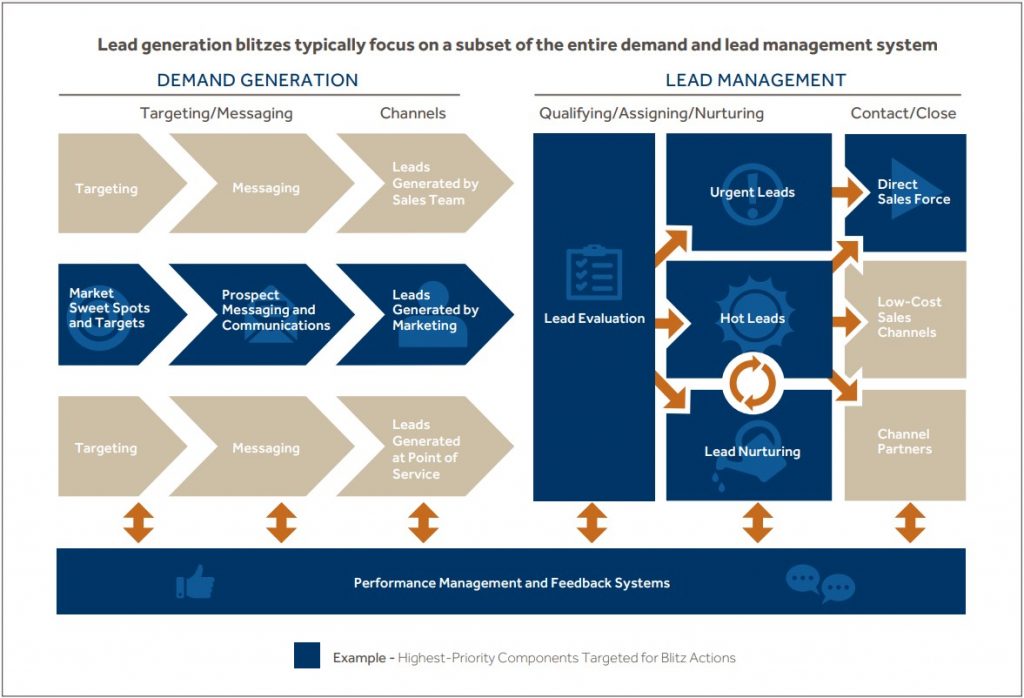
How? Commit the organization to a three-month effort to replenish the pipeline by generating and qualifying a specific target number of leads. Knowledge capital is critical here as prospective buyers are increasingly unresponsive to efforts to engage their attention that do not include useful information. Sales and marketing leaders should collaborate to identify a target market segment and a powerful message, then Marketing should work with thought leaders in the business to develop and package the content for the campaign.
Keep in mind that the number of outbound touches, even for a three-month effort, can be significant. Producing 100 qualified leads could easily require targeting 2,000 contacts with two or three quality touches each. That targeting effort requires generating and cleansing lists, in some cases managing versioning of email or direct mail, and tracking outbound calls and inbound responses.
Such a campaign is most easily executed with a CRM or Marketing Automation (MA) system. However, the absence of these systems should not stand in the way of undertaking the blitz. The campaign can also be managed with tools such as Excel spreadsheets that, while not readily scalable, are suitable for the time-limited blitz. We have seen several companies use the positive results of a lead generation blitz to provide the necessary proof-of-concept for implementing a more robust—and long-desired—CRM or MA system.
Once the campaign is underway, marketing or sales resources can qualify leads using criteria determined in advance by Sales, but in most cases, it will be more cost-effective for non-sales resources to qualify leads. Keep this in mind when the blitz is being used to trial-run possible qualification processes for future applications. During the blitz, communicate frequently with the team. Building active involvement and celebrating wins will not only generate better results, but it will also create buy-in, invite more effective feedback to improve the process, and increase momentum. This is true following the blitz as well. Be sure to wrap it up with a thorough, all-team post-mortem analysis and identification of the next steps for establishing more permanent capabilities.
What can be achieved with a lead generation blitz? A manufacturer of custom packaging for industrial equipment was experiencing slow growth—all of it from existing customers who were typically major accounts. The company knew if it could add just three major accounts a year, it would double the rate of new account growth. With a focused, three-month effort built around targeted knowledge capital and external resources to set up calls with large-account decision makers, the company generated seven qualified leads that yielded the desired three large customers. Furthermore, the blitz became the tool used to refresh the pipeline periodically when needed.
Top-To-Top Customer Engagement
Today’s B2B sales organizations are operating in an increasingly complex environment. Buyers have access to extraordinary volumes of information via the Internet and in many cases prefer to delay engaging with a salesperson until late in the buying process. Furthermore, many more categories of spend have become targets of formal procurement processes and functions, while purchases now have multiple decision makers and influencers.
Success in this environment requires many components, including content-based marketing, value selling, account planning, and team selling. For a blitz, the top-to-top meeting provides a limited and manageable initial target for improvement that can touch several important areas. At many companies, these meetings between the top business leaders of the supplier and customer, if they happen at all, are rarely optimized because they are too infrequent, irregular, and inadequately planned. However, a concerted effort to conduct a fixed number of high-quality top-to-top meetings can be the first step to widespread improvement in complex selling skills. How can simply having a number of meetings, even with top executives, make a big impact? The key is that it is not just meetings, it’s high-quality meetings. Consider what needs to happen for this blitz to be effective:
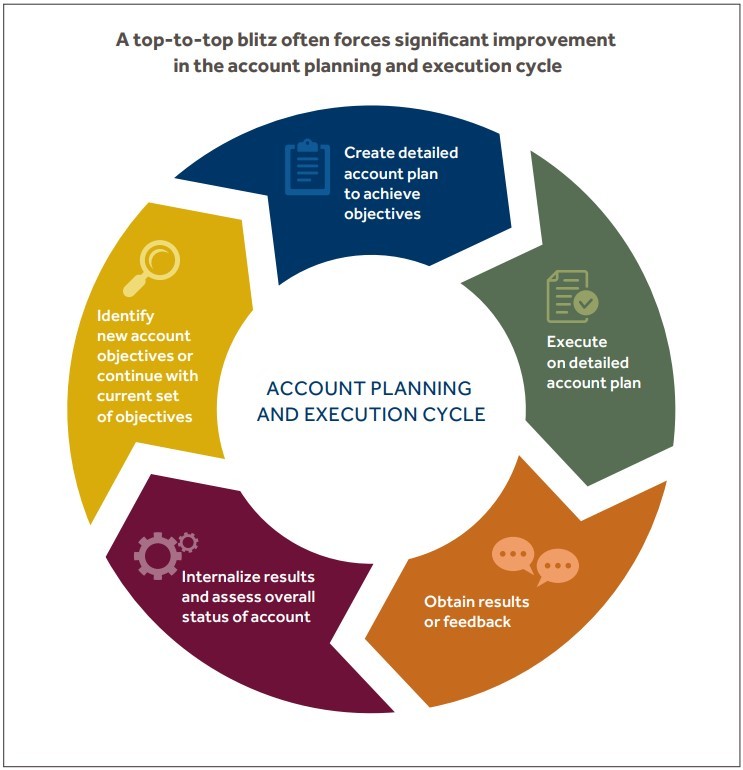
- Senior executives who will be representing the business need to consider how much of their time can be dedicated to the effort. Even if this is for a limited time, it sets a baseline for their involvement in selling efforts on a more permanent basis.
- Senior executives should direct their time to the highest-potential accounts and prospects. Selecting those accounts and prospects requires homework and analysis that often don’t happen at all or remains in the heads of salespeople and managers. Good account plans, including assessments of near-term opportunities, should be completed for potential targets of the top-to-top blitz. If a common account planning model isn’t in place or is inadequate, this is the perfect opportunity to address that issue.
- Account or pursuit teams need to form. At a minimum, the sales rep, sales manager, and executive need to be involved in setting the objectives and planning the pursuit, of which the top-to-top meeting is only the next step. In some cases, technical specialists, finance, supply chain, or service roles may also be involved. Leading these teams is a critical complex selling skill, and a focused initiative that ensures reps get the help and attention needed to succeed is a great way to start developing the skill.
- Executives must be prepared to conduct a business review during the top-to-top meeting. This review should communicate clearly how value is being driven for the customer in hard dollars-and-cents terms. Performing the business review exercises the organization’s value-selling capabilities and forces quick improvement if necessary. Done right, the business review also sets a higher bar for the quality of engagement with customers.
High-quality top-to-top meetings drive multiple improvements and typically are self-sustaining as senior executives are personally involved, underscoring the importance of the effort and keeping lower levels of the organization focused on it. Over time, the improvements seen from this effort tend to create both more and better business. For instance, one industrial materials supplier launched a top-to-top meeting blitz when it realized its customers were shifting from premium to commodity products due to (a) more intense procurement practices and (b) competitors’ efforts to erode the perceived value of its premium products.
The company decided to engage its customers at senior levels both to reinforce the value of its premium products and to keep its executives better connected to industry developments impacting those products. The blitz was so successful at establishing and deepening relationships with customers, it became a core element of the company’s sales strategy. The effort has not only reversed the erosion of the product mix, but it also produced a three-point improvement in EBITDA within eighteen months.
Pipeline Cleanup
High-performing commercial organizations are managed through metrics, and it is the sales pipeline that captures the health data of the business’s revenue engine. How many leads are being generated? At what rate and speed are they converted through the pipeline stages into sales? How does performance vary across the organization and over time? Is the current volume of leads and rate of conversion sufficient to meet revenue and growth targets?
Despite the importance of these metrics, we often find that businesses either don’t track them or don’t trust them due to poor quality information in the CRM system. Ironically, systems that make pipeline tracking easier may be contributing to the proliferation of pipeline junk, and some studies suggest that half of all pipeline data are inaccurate. As a result, the metrics are not actively used to manage the business. A blitz to clean up pipelines can fix this problem and quickly put the organization in a position to manage the commercial organization with solid data. Beyond the blitz, this cleanup effort can begin to transform the way sales teams are managed.
Pipeline Multiple as Function of Sales Cycle and Win Rate
Accurate pipeline metrics enable sales management to understand how drivers such as sales cycle, win rate, and pipeline size interrelate. Values in the table below are the Pipeline Multiple which is the Pipeline Value divided by the Sales amount need to hit the target.
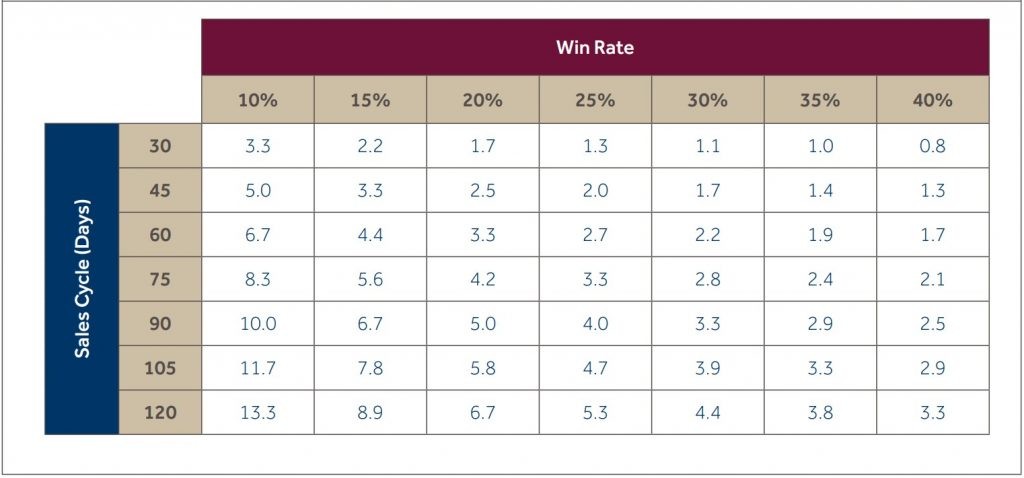
On the surface, creating and maintaining clean pipeline data is a straightforward exercise. Sales reps enter opportunities into the CRM or pipeline tracking tool and update them at least weekly, often in conjunction with weekly sales meetings. Clear rules determine when an opportunity is entered, how it is sized when it moves through stages, and when it is closed. If the current pipeline is incomplete, inaccurate, or contains old information, every salesperson must update and scrub their opportunities.
This is all easier said than done. Companies that undertake this exercise often experience problems with their reps following it through to completion or not using good judgment in determining the status of both old and new opportunities. Ultimately, the solution lies with the sales manager. A sales manager who is focused on a clean and accurate pipeline can have a significant impact on performance. Consider what can happen when a sales manager conducts a diligent pipeline review with his or her sales team each week:
- The manager who regularly reviews pipeline data is better able to stay on top of big opportunities and delve into situations that don’t seem right, such as deals that close within days of first entry. This consistent and active use of data leads sales reps to be timely and accurate in their data entry. Even more powerfully, the sales manager becomes smarter about the business and develops a stronger understanding of how the drivers of sales performance interact and where to focus to improve results.
- Regular pipeline reviews create an opportunity to re-examine the sales process as well as train and reinforce how selling is done at the company. When is an opportunity qualified to include in the pipeline? What stages should the salesperson follow? How long should each stage take? What percentage of opportunities should convert from stage to stage? Keep in mind that the sales process must be clearly defined, widely understood, and reflect how high performers actually sell.
- Pipeline reviews pinpoint where sales reps need help. These are often opportunities that are stuck or otherwise at risk. Many sales reps are reluctant to ask for help, but by making a regular schedule to discuss opportunities using objective data, sales managers create an environment conducive to coaching that improves rep performance over time.
- Frequent pipeline reviews grounded in good data help sales managers reach confident conclusions about low performers more quickly. Without data and frequency, identification of underperformers and action on them often come too late.
To launch the pipeline cleanup blitz, begin by addressing any issues in the sales process definition and pipeline tracking systems. Next, set a target. Ideally, the goal is 100% clean pipeline data, but this is nearly impossible to measure. A more practical goal is the absence of any substantial errors in the pipeline. Soft testing of this goal based on a pipeline review by senior executives, typically the CSO or CFO with the sales managers, is often adequate to be comfortable that the pipeline is clean. A more rigorous approach is to audit a sample of specific opportunities from every sales rep and manager. If the resources exist to pursue the audit approach, it is an excellent mechanism to adopt and maintain pipeline quality going forward.
Realistically, it will require many detailed reviews of the pipeline to ensure all the bad data are ferreted out and that new opportunities are being entered into the system accurately. It is time well spent as a clean and reliable pipeline is more than good data—it’s a litmus test of a well-defined sales process and disciplined sales management. With its ability to touch so many performance areas, a clean pipeline is a valuable blitz opportunity that can lead to significant growth.
One industrial distribution client made a pipeline cleanup blitz a key element of a broader effort to implement common sales management processes. Prior to the blitz, the company’s pipeline data were widely viewed to be exaggerated, and the size of the pipeline was, as a rule, routinely reduced by two-thirds to more accurately portray the
size of the opportunities. After the three-month blitz, the company, for the first time ever, had an accurate view of its pipeline, could understand the status of specific opportunities and could measure differences in the performance of individual sales reps. With this information, it was able to effectively manage the adoption of common sales processes, which within one year yielded a 30% improvement in selling time while doubling growth in pipeline opportunities.
Performance Improvement For Lowest Profitability Customers
Almost every B2B firm has a “tail” of customers who contribute very little to overall earnings growth. For many businesses, the tail includes a number of unprofitable and underperforming customers—often many more than companies realize. These customers consume a disproportionate share of both management’s and the sales organization’s time relative to the contribution they are making. Addressing this tail and reallocating time to higher-growth opportunities are powerful levers for improving the bottom line.
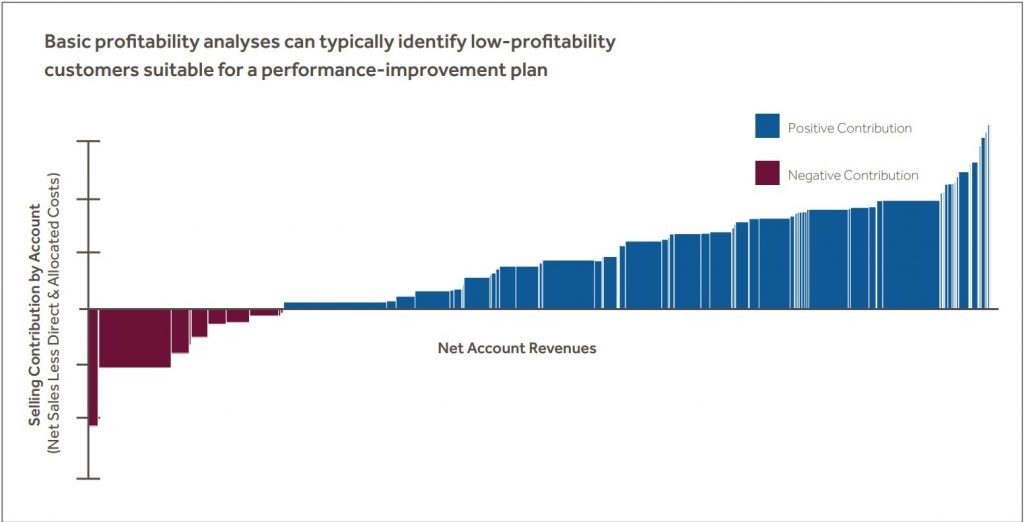
A blitz focused on developing performance improvement plans (PIPs) for underperforming customers can trigger a more sustained improvement in managing customer profitability. Development of these plans typically occurs in five steps:
- Seek to better understand the tail. What is the threshold for acceptable profitability in the absence of strong growth potential? What do these customers represent in terms of their revenues, gross profit, sales, marketing, and service costs? What are the underlying drivers of their low profitability (e.g., low volume, over-servicing, low prices, etc.)? One important input into this analysis is cost-to-serve. This may be a good opportunity to begin measuring the true cost-to-serve if this is not already done.
- Develop a menu of strategies and playbooks for addressing drivers of low profitability to help the sales teams understand their options. The menu may include both short- and long-term actions. For example, customers who are being over-serviced, but do not require such a high touch, could be migrated to a lower-cost sales or service channel. For other customers, selective price increases may be appropriate to compensate for low-volume purchases. The playbooks would include specific actions for the field to apply and execute each of these strategies.
- Create PIPs for each customer below threshold profitability and be as specific as possible. They should include measurable objectives and key actions, including assigned resources and expected timing. It is important that the plan also describes what happens if the objectives are not met within a set timeframe.
- Actively manage against the PIPs and track progress. This should be an explicit topic that is part of regular sales meetings. Managers and reps should look at how much improvement has been measured within the last month, quarter, etc. Where goals are not achieved, take action and exit customers.
- Re-evaluate the tail. As the bottom-performing customers improve or are released to the competition, they may be replaced by new tail customers in need of a PIP. Regular evaluation of the tail and creation of PIPs should become part of the routine process of managing the business.
For many companies, a low-profitability customer blitz will only target a portion of underperforming customers in order to make the effort achievable within a short time frame. One good way to limit the scope of the effort is to focus on either larger or smaller low-profitability accounts as each of these groups is likely to have different root causes of their status and, therefore, different solutions.
As with all blitz efforts, there may be upfront work required to acquire data, perform analyses or set up tools to track customer profitability and the potential impact of various improvement measures. It is important not to over-engineer this work or strive for perfection. Especially for a blitz targeting the lowest tier of below-target customers, metrics can be less than perfect without creating genuine doubt that action is needed for these customers.
What targets are reasonable for this blitz and what value can be driven? At one specialty plastics manufacturer, 200+ customers comprised 30% of accounts but only 2% of sales and 0.3% of gross margin. And 30 of these customers generated negative gross profit. After conducting a low-profitability blitz, the company addressed its tail through re- pricing as it provided a specialized product that was critical to customer applications and could not be easily substituted. The result of the blitz was a seven-point improvement in EBITDA margin. While the solution was relatively easy to fully execute, the blitz forced leaders to confront a chronic profitability leak they previously had under-appreciated. Indeed, part of the power of the customer profitability blitz is that it forces action in an area where companies are often reluctant to take action. Given the need to get information, assess the situation, create a plan, and drive actions that may include multiple discussions with customers, this blitz may require up to six months to fully execute. Regardless of the time, the important thing is to set a target date and stick to it.
Four Blitzes—Many Paths to Improvement
These four blitzes won’t address all of the potential areas for improving commercial performance, but they collectively can lead to almost all areas. For example, the top- to-top customer engagement blitz requires improvement in content-based marketing, value selling, account planning, and team selling. The pipeline cleanup blitz not only fixes the pipeline but also better defines the sales process and creates more disciplined sales managers. These linkages are shown below, illustrating how these four blitzes collectively touch a significant number of common improvement opportunities.
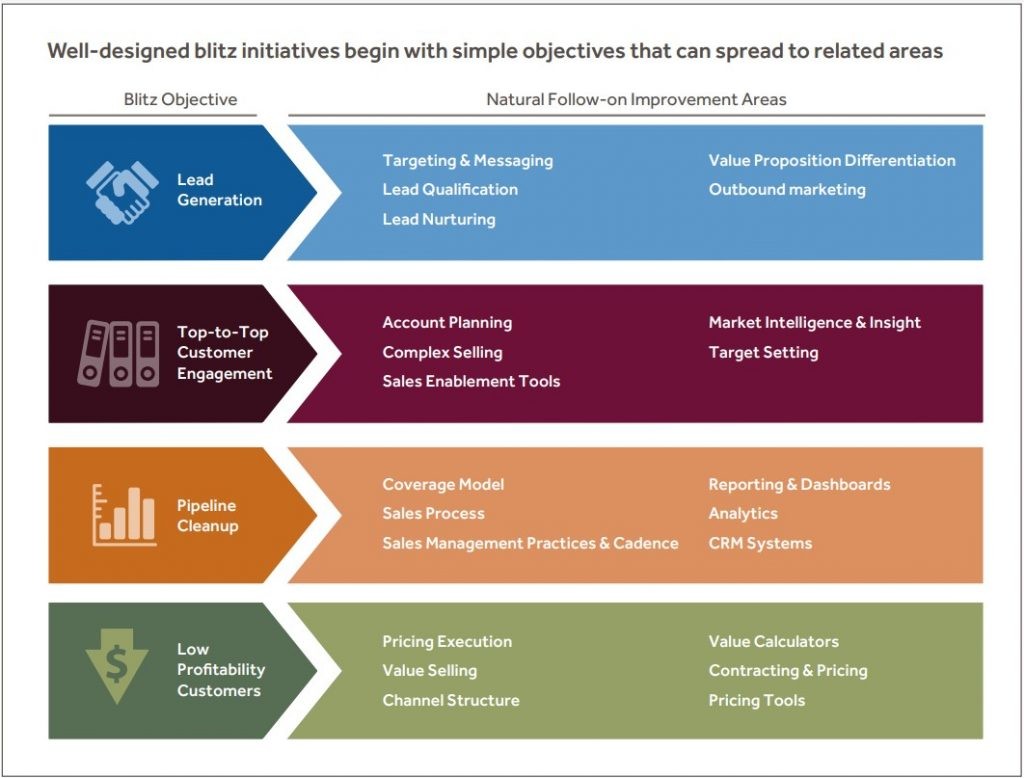
Most companies know when they are not achieving their full growth potential, they just don’t know what to do about it. Either there are so many promising areas for improvement they aren’t sure which one to tackle first, or they have an inkling of where to start, but the problem is so ingrained and far-reaching it would appear to require an enormous investment and long-term commitment of time. The blitz approach solves both these challenges, giving companies a way to kick-start growth with an effort that is manageable and impactful, ultimately creating momentum for further improvements.


